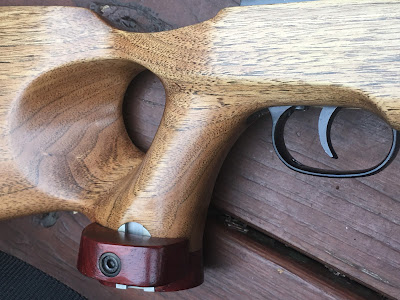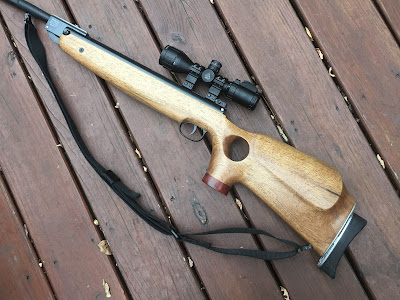Something a bit different today--a quick revisit. Been at least six years now since the .22 cal BAM B26-2 has seen the light of this blog. Thought I'd follow up with how it's been going. Forgive me as I'm not finding all the right words to express myself this morning, but I'm plugging along anyway. If you've followed this blog, you'll recognize that I've long been fascinated by the mechanicals and the ergonomics of dedicated target-type guns. The precision accuracy coupled with the adjustability of the stocks and grips made an impression. There's a uniqueness and almost a science fiction aspect to some of the equipment. All purpose driven to improve the shooter's results. My mechanical aptitude is attracted to that uniqueness, the engineering and manufacturing. And since I'm interested in experiencing these features--especially in a price range I can afford--I attempt to incorporate some of them into my various field/sporter airgun projects.
Originally purchased this (in person!) at a Pyramyd Air open house. Way back in 2008, this rifle for some reason was on my hit list. It was a lot of things. Wanted to try a thumbhole stock, it was available in .22 cal, liked the overall design, wanted to see how the quality of the BAM air rifles had progressed...
Spent some time working out the accuracy and ergonomic issues the rifle presented. Certainly got some blog fodder out of it--maybe 12 or 13 posts worth. This rifle (and an evil Remington Summit) taught me quite a bit about how important positive, consistent barrel lock up is--and how difficult it can be to achieve. The 26-2 also really drove home the point about ergonomics and fit. The original high cheek piece made it impossible to get a comfortable position behind the scope. Even with high rings and a riser adapter, I was smashing my face into the stock to see through the scope. Amazingly, after lowering the absurdly high comb, this is now one of my favorite rifles to shoot offhand. That adjustable palm shelf and buttpad allow the rifle come to point immediately because the hold is so consistently repeatable.
The padauk wood has darkened and mellowed a bit from the bright red when it was freshly cut. This particular feature was inspired by the Anschutz 1913 Supermatch rifle.
The quick set Devcon epoxy is still holding the rubber pad to the aluminum plate without any gaps.
Made a replacement pivot pin for the cocking linkage at some point. Nearly identical to the one we blogged for the .25 cal R1.
Seems like the only real change over the years was a scope upgrade. Originally, I believe the B26-2 was wearing a fixed 4X power Leapers Bug Buster. Switched to the 3-9 variable power Bug Buster a few years ago backed up by a separate scope stop.
The scope eye relief combined with the short mounting area for the rings wouldn't allow the stop pin in the scope ring to line up with the hole in the receiver. The separate scope stop solved the problem.
There were quite a few modifications made over the years--from the stock surgery to the chisel detent barrel latch. The 26-2 slowly morphed into a very fine shooter. The scope relative to the bore line is still high, but it's now a very comfortable heads up position rather than a smooshed face position. I look back at the original comb height and marvel that BAM designed a stock solely for a guy like Herman Munster. I should put the rifle across the chronograph again and see where the velocity is compared to the original tune over a decade ago.
Maybe later this week just for fun...










